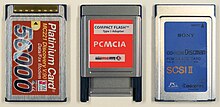
Back بطاقة الحاسوب الشخصي Arabic পিসি কার্ড Bengali/Bangla PC kartica BS PC Card Catalan PC Card Czech PC Card German PC Card Spanish PC-kaart Estonian PC-Card French पीसी कार्ड Hindi
 | |
 Various PC Cards, with the left one being a CardBus PC Card | |
| Year created | 1990 |
|---|---|
| Created by | Personal Computer Memory Card International Association |
| Superseded by | ExpressCard (2003) |
| Width in bits | 16 or 32 |
| No. of devices | 1 per slot |
| Speed | 133 MB/s[citation needed] |
| Style | Parallel |
| Hotplugging interface | Yes |
| External interface | Yes |
PC Card is a parallel peripheral interface for laptop computers and PDAs.[1]
The Personal Computer Memory Card International Association (PCMCIA) originally introduced the 16-bit ISA-based PCMCIA Card in 1990, but renamed it to PC Card in March 1995 to avoid confusion with the name of the organization.[2] The CardBus PC Card was introduced as a 32-bit version of the original PC Card, based on the PCI specification. The card slots are backward compatible for the original 16-bit card, older slots are not forward compatible with newer cards.
Although originally designed as a standard for memory-expansion cards for computer storage, the existence of a usable general standard for notebook peripherals led to the development of many kinds of devices including network cards, modems, and hard disks.
The PC Card port has been superseded by the ExpressCard interface since 2003, which was also initially developed by the PCMCIA. The organization dissolved in 2009, with its assets merged into the USB Implementers Forum.
- ^ Imdad-Haque, Faisal (1996). Inside PC Card: CardBus and PCMCIA design. EDN series for design engineers. Boston: George Newnes Ltd. ISBN 978-0-7506-9747-7.
- ^ Rathbone, Tina (1995-12-18). Changing of the card. InfoWorld Media Group, Inc. p. 87.
{{cite book}}: CS1 maint: date and year (link)
© MMXXIII Rich X Search. We shall prevail. All rights reserved. Rich X Search